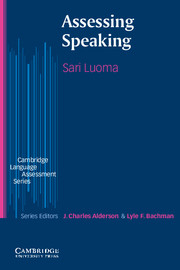6 - Developing test specifications
Published online by Cambridge University Press: 03 May 2010
Summary
It is useful to begin the development of a test by writing test specifications, and this is what this chapter will discuss. The first part gives an overview of test specifications, their purpose and their contents. The second part presents three examples of specifications: one for a stand alone speaking test in an EFL classroom, one for a university entrance examination, and one for a proficiency test for adults. The purposes of the tests are different (achievement, selection, certification), and so are the examinee populations. Nevertheless, the structure of the specifications is fairly similar.
Specifications: What? and why?
Anyone who develops a speaking assessment will have ideas about what kind of speaking it will focus on, how the assessment will be done, and what the rating criteria will be. The written version of these ideas is called the test specifications, or specs for short. The specifications contain the developers' definition of the construct(s) assessed in the test, and detailed definitions of the tasks and rating criteria to guide the development of comparable tasks and the delivery of fair ratings. The specifications record the rationale for why the assessment focuses on certain constructs, and how the tasks and criteria operationalise them.
There are several frameworks in language testing literature that explain the structure and the purpose of test specifications (e.g. Lynch and Davidson, 1994; Alderson et al., 1995; Bachman and Palmer, 1996). The recommendations that the different frameworks give for the contents of test specifications are almost identical.
- Type
- Chapter
- Information
- Assessing Speaking , pp. 113 - 138Publisher: Cambridge University PressPrint publication year: 2004



